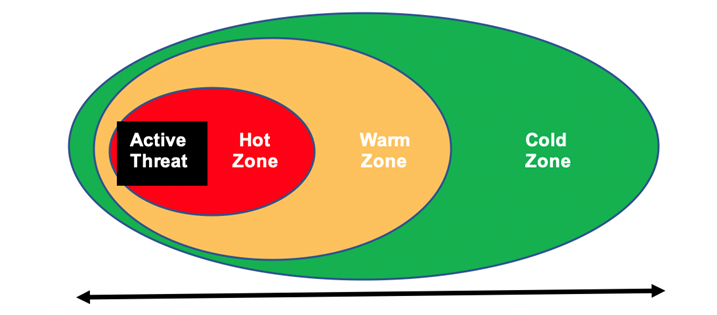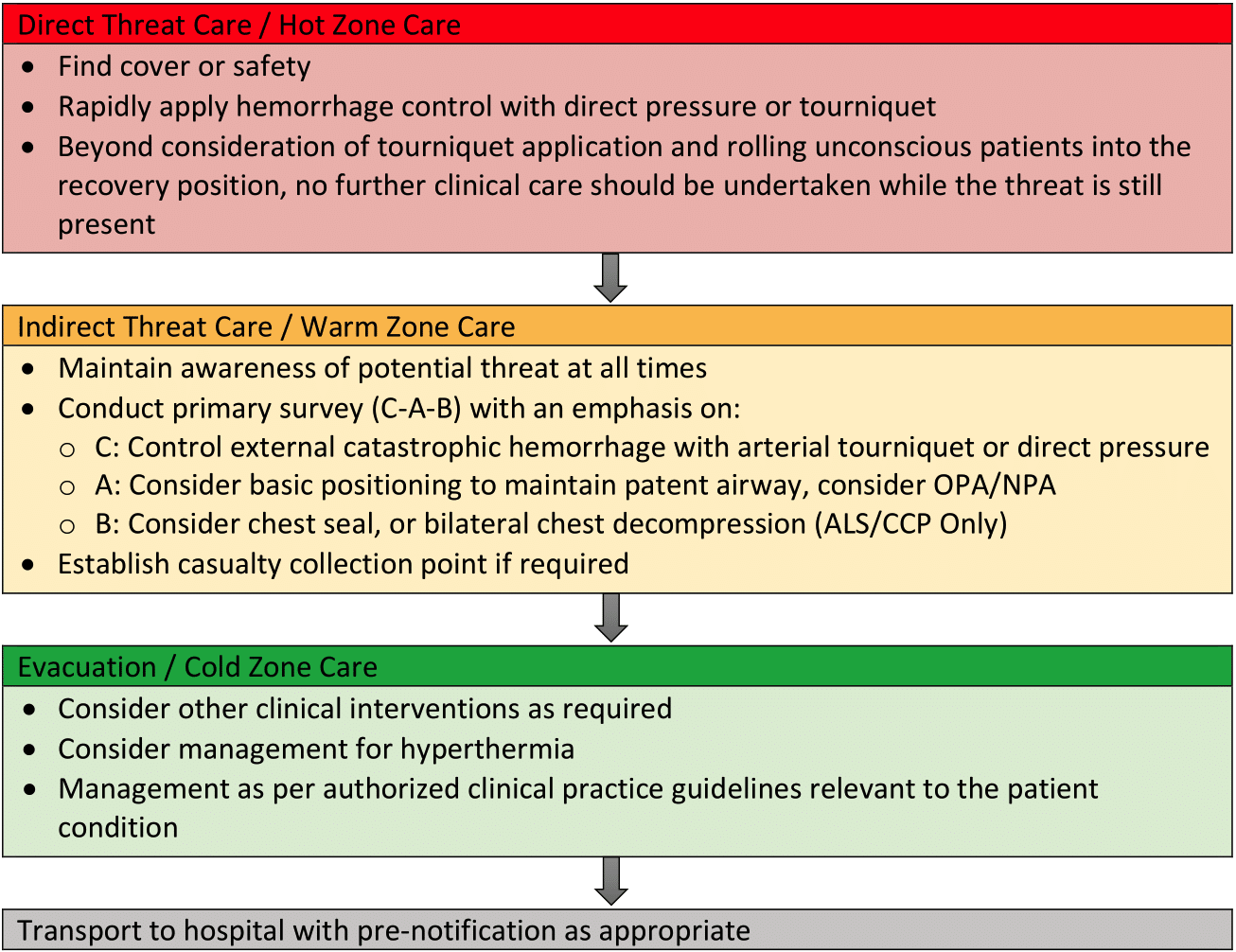Confirmation
A11: Care in High Threat Environments
Reviewed: December 1, 2020
Introduction
A high threat incident is any that involves the potential or actual risk of physical harm to responders as a result of dangers inherent at the scene. This can include the use of firearms or edged weapons, fire, rising floodwaters, or unstable structures to name a few.
While responders should not knowingly place themselves in areas of high threat, recent events such as the 2014 Ottawa Parliament Hill shooting, 2015 Paris terror attacks, and 2017 London attacks, have shown that first responders may inadvertently find themselves in such a situation. This guideline therefore sets out considerations for safety and clinical care in high threat incidents.
Types of Threats
Threats generally come in two forms, man-made and naturally occurring.
Man-made threats: the Active Armed Offender
The term ‘active shooter’ makes a direct reference to the use of a firearm or firearms, but an incident may also involve any weapon type such as bladed weapons, explosive devices, and any improvised object capable of inflicting serious injury or death, including vehicle borne intrusions. This is why the term Active Armed Offender (AAO) has been adopted.
These attacks are aimed at people rather than infrastructure and against relatively soft targets. They can occur with little or no planning, intelligence, or forewarning.
While the term ‘extremist’ is very topical at this time, particularly in the media, it is important to realize that not all AAO incidents are motivated by extremism or perpetrated by religious or ideologically-focused individuals. An AAO incident can also include an individual with a serious fixation and/or a serious mental health issue, motivated by hatred or revenge, or involve criminal intent.
Hybrid Targeted Violence Incident
A Hybrid Targeted Violence Incident (HTVO) refers to the intentional use of force to cause physical injury or death to a specifically identified population using multifaceted conventional weapons and tactics.
This may involve a criminal act, such as the 2017 Bourke Street Mall incident in Melbourne, through to a terrorist incident such as the complex, coordinated 2008 Mumbai attacks.
Naturally Occurring Threats
This could include wildfires where a fire is imminently approaching, rising flood waters or flash floods, avalanches or landslides, earthquakes, or tsunamis.
What is the Current Terrorism Threat Profile in Canada?
'Canada's National Terrorism Threat Levels' is a tool that government officials, including law enforcement agencies, may use to identify risks and vulnerabilities from threats, and in turn, determine what responses may be needed across government to prevent or mitigate a violent act of terrorism in Canada.
The current threat level can be reviewed here.
What is Tactical Emergency Casualty Care?
Tactical Emergency Casualty Care (TECC) is a set of best practice treatment guidelines for trauma care in the high threat out-of-hospital environment. These guidelines are built upon critical medical lessons learned by military forces over the past 15 years of conflict. They are appropriately modified to address the specific needs of civilian populations (e.g., anticoagulated patients, extremes of age, etc.) as well as injury patterns typically seen in traumatic incidents and adapt these principles to civilian paramedic practice.
At the core of TECC are three distinct zones of care:
- Hot Zone (Active Threat) – a dynamic area of operations where there is an active threat of harm (safety risk to patients, bystanders, and emergency response personnel)
- Warm Zone (Indirect Threat) – a dynamic area of operations where a potential threat exists, however the threat is no longer considered direct or immediate
- Cold Zone (No Threat / Area Secure) – an area of operations where there is no threat present and the scene is considered to be an area of absolute safety

Direction of Threat
It is important to remember that the direction of the threat is dynamic and can change at any time. This is especially relevant in wildfire and terrorism related incidents.
No BCEHS responder is to intentionally enter a known Hot Zone at any time. If a responder finds themselves within a Hot Zone, they are to immediately find cover or safety, and to withdraw to a Cold Zone as soon at it is safe to do so.
Clinical Management of Patients Based on Threat Level
The clinical management of patients and role of all responders is strictly dependant on zones of care. TECC focuses on the treatment during these phases of care and provides guidelines for managing trauma in the civilian tactical or hazardous environment.

